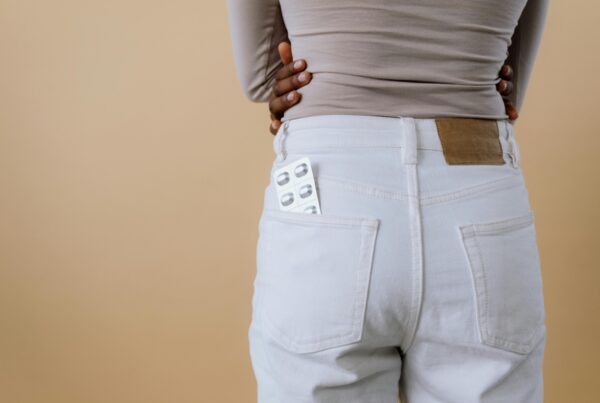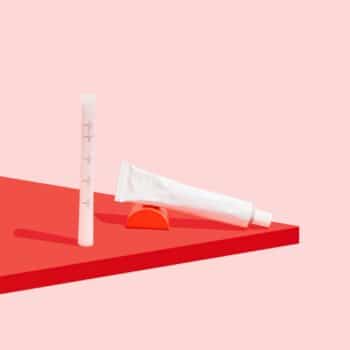Something’s going on downstairs, and it might be menopause
Although you may think that menopause and UTIs seem completely unrelated, the changing hormone levels experienced during perimenopause and menopause can lead to a whole host of symptoms, many of which can affect our vulvas and vaginas!
If you’ve been getting more urinary tract infections (UTIs) than you’re used to, it might be time to start checking for other symptoms of perimenopause and menopause too, as recurring UTIs can be an overlooked first sign you are entering this transition.
In this blog post we’re breaking down everything you need to know about something called Genitourinary Syndrome of Menopause (GSM). The word ‘syndrome’ can sound scary, but there’s no need to run for the hills. With the help of Wisp, we’re here to clear up any questions and give you the download on how to get on top of those recurring UTIs!
The lesser-known symptoms of menopause
Many of us are familiar with the symptoms of perimenopause and menopause that get called out in the media; the ones that make us want to crank up that AC and let loose at our families. Perimenopause and menopause is more than just hot flashes and mood swings though.
During perimenopause and menopause, your levels of estrogen, progesterone and testosterone decline. This change in hormone levels can cause symptoms that have a major impact on many aspects of our lives. This includes not only the common symptoms we are familiar with, but also lesser known sneaky ones that sometimes get dismissed.
A particularly important set of symptoms caused by falling estrogen levels often overlooked is genitourinary syndrome of menopause (GSM). GSM is a broad term used to describe a variety of different symptoms, but GSM is most commonly characterized by:
- Dryness in and around the vulva and vagina.
- A reduction in vaginal elasticity.
- A thinning of the labia majora and minora tissue.
- A weakening in the pelvic floor and part of the bladder.
- Changes in the sensitivity of the nerve endings in the clitoris.
- An increase in urinary symptoms such as urgently needing to pee or recurrent infections.
How may GSM affect you?
You might be wondering how exactly these symptoms could affect you, and how menopause and GSM could lead to recurring UTIs. The short answer is that the symptoms of GSM leave us more exposed downstairs, making it more likely for us to develop conditions, irritations, and to experience discomfort.
For instance, UTIs result when bacteria infects parts of the urinary tract- which includes the kidneys, bladder, and urethra. These UTI-causing germs often travel to infect the urethra from the nearby vagina.
For those of us who have not yet begun to experience the symptoms of perimenopause and menopause, our vaginal fluids help to prevent these bacteria from growing and causing infections.
However, falling estrogen levels during perimenopause and menopause cause our bodies to produce less protective fluid which leads to our protective tissues becoming thinner. These hormonal changes are what make us more vulnerable to developing UTIs during perimenopause and menopause!
Similarly, GSM can leave us more susceptible to conditions such as thrush (vaginal yeast infections), and a weakening of our bladders and pelvic floors, which can make us more likely to experience incontinence. Overall, GSM can leave us feeling fragile and cause discomfort when going about activities such as bathing, exercise, and having sex.
Luckily, women who are going through perimenopause and menopause have options, and we don’t have to let these symptoms dictate how we live our lives!

.
Treating ourselves right during menopause
While we can’t avoid changing hormone levels during perimenopause and menopause, we can flip the script and take on our new symptoms head on. In fact, there’s an array of treatments we can explore, and small changes to habits that can ease discomfort caused by GSM.
Here are some of the treatment options to explore:
Vaginal Estrogen
- Reduced levels of estrogen are what cause symptoms of GSM.
- As such, supplementing our bodies with the estrogen that’s being lost is the most effective way to combat symptoms of GSM.
- Many women find relief from using vaginal estrogen creams, tablets, or rings. These products are placed into your vagina, where they release small amounts of estrogen into nearby tissues to help combat vulvovaginal symptoms.
Supplementing your vaginal tissues to compensate for lost estrogen means you can improve the amount of lubrication your body produces downstairs, lessening soreness, dryness, and itchiness as a result.
Another benefit of using this type of medication is that it’s absorbed directly into the vagina and surrounding tissue. Direct application means you’ll notice beneficial effects with low doses.
Women are often worried about using vaginal estrogen because of things they have heard about an increased risk of developing certain cancers. Recent research has shown that there is NO increased risk associated with using vaginal estrogen and developing cancer. It is a perfectly long term safe treatment to use.
Antibiotic Medications
- For those of us who are getting more UTIs as a result of GSM, medications that target infection-causing bacteria can be helpful.
- While these medications do improve the symptoms of UTIs they can also get rid of the beneficial bacteria that protects your vagina.
- This can leave you more vulnerable to contracting certain infections, and can add to feelings of dryness downstairs.
For this reason, you may want to make sure that you take lower doses of these medications, and avoid taking them for longer periods of time, unless specified by your doctor.
Antibiotic medications will provide you with relief from your symptoms but they will not necessarily prevent you from getting more infections in the future. These medications will likely need to be combined with other treatment options to help keep your vulva and vagina feeling fine!
D- Mannose
If you’re looking to treat a UTI and wish to avoid using antibiotics, you could consider using D-mannose. This supplement is thought to work by preventing UTI-causing bacteria from infecting our urinary tracts, and is more easily accessible than prescription medications. However, further research regarding the effectiveness of D-Mannose is still needed.
Whether you’re looking for antibiotics or supplements such as D-mannose, you can find accessible treatment options through Wisp.
Taking care downstairs is about more than medication
While you should use medications that help you find relief, some research actually suggests that first-line treatment for symptoms of GSM should involve lifestyle changes.
These changes are typically easy to incorporate into your daily routine, and can include using lubricants and moisturizers to tackle dryness. It also includes taking part in activities such as physical therapy, which can help you to strengthen the muscles of your pelvic floor that may have weakened as a result of GSM.
If lifestyle changes and medications are not helping you to find relief, you should tell your doctor pronto! What works for some people won’t necessarily work for you, and that’s totally normal! If it helps, keep track of how new medications and lifestyle changes make you feel, so you are able to share progress with your clinician the next time you see them.
Equally, while it can feel exposing to talk to a healthcare provider about vulvovaginal symptoms it’s really important to seek support. 80% of women in perimenopause and menopause experience GSM related symptoms, but only 10% of these women seek treatment. We don’t need to suffer in silence and support is available!
Help is here if you need it!
If you’re experiencing symptoms of GSM such as recurrent UTIs, and are now wondering if you might be going through perimenopause or menopause, use our symptom tracker to assess for signs and symptoms. You can also check out our general resources on perimenopause and menopause. Our information will give you the lowdown on timelines, symptom management and strategies to make navigating perimenopause and menopause more manageable.
This blog post was part of a collaboration undertaken with Wisp. For other great reads on important women’s health topics, and information about accessing treatments fast, head over to Wisp’s blog.

References
Angelou K, Grigoriadis T, Diakosavvas M, Zacharakis D, Athanasiou S. The Genitourinary Syndrome of Menopause: An Overview of the Recent Data. Cureus. 2020;12(4):e7586. Published 2020 Apr 8. doi:10.7759/cureus.7586
Baik SH, Baye F, McDonald CJ. Use of menopausal hormone therapy beyond age 65 years and its effects on women’s health outcomes by types, routes, and doses. Menopause. 2024;31(5):363-371. doi:10.1097/GME.0000000000002335
Caretto M, Giannini A, Russo E, Simoncini T. Preventing urinary tract infections after menopause without antibiotics. Maturitas. 2017;99:43-46. doi:10.1016/j.maturitas.2017.02.004
Da Silva AS, Baines G, Araklitis G, Robinson D, Cardozo L. Modern management of genitourinary syndrome of menopause. Fac Rev. 2021;10:25. Published 2021 Mar 3. doi:10.12703/r/10-25
Freedman MA. Quality of life and menopause: the role of estrogen. J Womens Health (Larchmt). 2002;11(8):703-718. doi:10.1089/15409990260363661
Stuenkel CA. Menopausal Hormone Therapy and the Role of Estrogen. Clin Obstet Gynecol. 2021;64(4):757-771. doi:10.1097/GRF.0000000000000648






